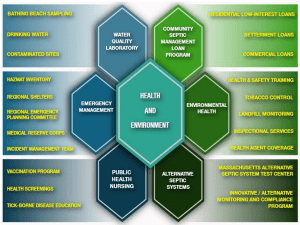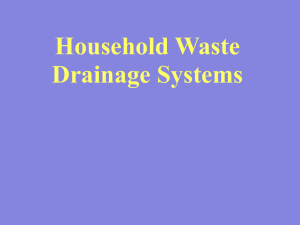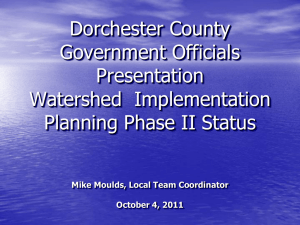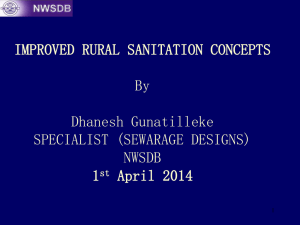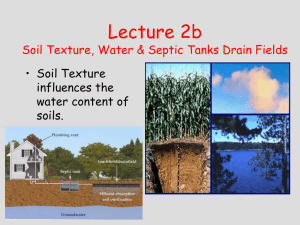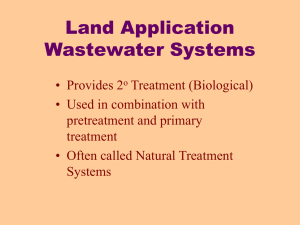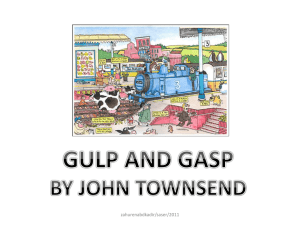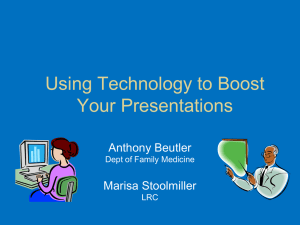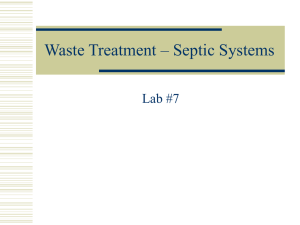Septic 101, North Bay Mattawa Conservation Authority
advertisement
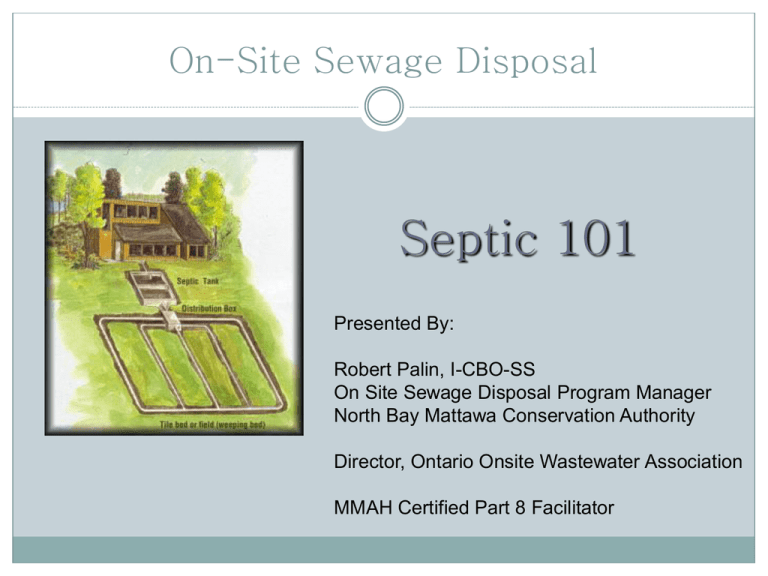
On-Site Sewage Disposal Septic 101 Presented By: Robert Palin, I-CBO-SS On Site Sewage Disposal Program Manager North Bay Mattawa Conservation Authority Director, Ontario Onsite Wastewater Association MMAH Certified Part 8 Facilitator Common Questions How can you tell if it is functioning properly? Are there new regulations concerning septic systems? Are there different rules for waterfront? How long does a septic bed last? How often does it need to be emptied? Can you plant a garden on it? Can you cut the grass with a riding lawnmower? Can you drive on it? Site Plan Types of Septic Systems Class 1: Privies; outhouse, portable & composting toilets Class 2: Leaching pit (grey water pit) Cesspool Class 3: Class 4: Septic tank Leaching bed Aerobic Systems Biofilter (media) Chamber Systems Class 5: Holding Tank Class 4 Septic Systems Septic Tank Wastes from the kitchen, bathroom, toilets, and laundry enter the septic tank were the separation of liquids and solids occur The lighter solids float to the top, producing a scum layer which assists in odour control The heavier solids sink to the bottom where they form the sludge layer The organics are broken down by bacteria in your septic tank system Once the organics are broken down, the liquid part leaves the septic tank An effluent filter (if installed) will assist in keeping solids in the septic tank Leaching Bed System In the leaching bed system, the partially treated wastewater from the septic tank is discharged into the soil. Away from the warmth of the human body, bacteria and viruses are killed off and more nutrients are broken down as the wastewater passes through the soil filter system Sundridge Zoning By-Law 3.15 – Setbacks from Streams and Watercourses No building or structure shall be permitted within 20m of a stream or watercourse. In addition, the following provisions apply to lands abutting Lake Bernard. 1. The minimum opening elevation of all new structural development excluding docks and boathouses near the shoreline of Lake Bernard shall be flood proofed to a minimum elevation of 330.5m based on Canadian Geodetic Datum. 2. All new structural development, excluding docks and other structures that by their nature must be located at the shoreline, will be set back a minimum of 20m from the average summer water level of Lake Bernard or above an elevation of 332.5m based on CGD. Strong Zoning By-Law Zoning By-Law 2005-1511 (Amendment to 93-1307): 3.27 - Setbacks from Watercourses and Fisheries Habitat: •The minimum setback from the top-of-bank of any cold water stream as identified on Schedule A-1 for any •building or structure, including septic systems, shall be 30m. •The minimum setback from the top-of-bank of any other stream or watercourse as identified on Schedule A-1 for •any building or structure, shall be 15m. •Notwithstanding any other shoreline setback specified in this By-Law, on Lake Bernard, the minimum setback •from any Type 1 Fish Habitat as identified on Schedule A-2 for any building or structure, including septic systems, shall be 30m 3.12 – Minimum Opening Elevations – Lake Bernard is 330.5m (CGD) Be Good to Your System Keep the area of the septic bed grassed and mowed Do not plant bushes or gardens on your bed Do not drive on or near your bed Ensure that surface water flows away from the septic bed Keep the area of your septic bed in direct sunlight Signs of Failure Your septic system may be failing if: A foul rotten-egg smell is noticed Your tank overflows The soil around the tank is soggy Yours drains are slow or overflow There is a gurgling sound when sinks are drained A foul smelling liquid leaches out There is dark green grass around your tank and/or bed There is a wet, black oozy liquid around the trenches Your septic system may fail for any of the following reasons: – – – – – Your leaching bed is not coping Your septic tank is full, get it pumped out! There is too much water going into the system, check for leaks, reduce water usage, Toxic substances are being flushed into your system killing the bacteria before treatment can occur, eliminate/reduce the use of harsh chemicals Your septic system has out lived it’s life (approx 20-25 years) How Your Septic System Can Impact On The Water Cycle If your septic system fails then the effluent from it may pollute the water in your well, local streams, rivers and lakes Discharges from failing systems contain bacteria, viruses and nutrients that will harm the environment These materials can be both bad for your health and the environment. For this reason it is vital that your septic system is maintained and operated properly and that you do not dispose of medicines, pesticides, paints, varnishes, thinners and other harsh chemicals in your septic tank Keeping Your Septic System Happy! You can put wastewater from your sinks, baths, toilets, washing machine, and dishwasher into your septic system Be aware that kitchen garbage grinders will likely overload your system with solids thus effecting the treatment efficiency of your septic tank and require pump-out services more frequently Water softeners and pool discharges should not be directed into your septic system Typically septic tanks should be emptied every 3 to 5 years depending on use Septic disposal beds are designed to last 20 – 25 years depending on use Happy “IDEAS” Scrape your dishes, minimizes fats, grease, oil and solids from entering your septic tank If it doesn’t come out of your body do not flush it Ensure hair does not go down the drain Shake all dirt and sand from your clothes prior to washing them Use laundry detergent (phosphate free) in moderation and spread your laundry loads throughout the week Conserve water whenever possible, only run automatic washers when full Use water efficient appliances Divert surface water from the area of your septic leaching bed Install an effluent filter on the outlet end of your septic tank Learn the location of all the components of your septic system and how to maintain them Wet Wipes Vs. Your Septic System Just a decade ago the only wet wipes were for baby’s bums. Now with society’s need for cleanliness and convenience there has been an explosion of wipes for virtually every household chore and every part of the body. A recent Consumer Report put three wipes, along with toilet paper, through a disintegration test. It simulates what may happen when flushing and gives consumers a look at how the product could affect their pipes. Toilet paper tends to break down in about eight seconds. In contrast, "flushable" wipes lasted well beyond 30 minutes. These flushable wipes performed very poorly in their disintegration tests and may result in damage or backup of your septic system. Pharmaceuticals and your Septic System Medications can be harmful in septic systems. Safely dispose of unwanted medications, protect the septic system, manage systems during high medication use High concentrations of antibiotics or chemicals can kill or retard the growth of the bacteria in septic tanks and in the soil treatment drain field. If the use of strong medications is extended, it may be necessary to use the septic tank as a holding tank. This prevents the drugs from reaching the drain field and the groundwater. Dispose of Extra and Expired Medications Safely Cleaning the medicine cabinet, and find expired medications? Take care to protect personal privacy, prevent theft and protect water quality. Do not dump extra medications into the toilet. •First, check with the pharmacy. Many now take extra drugs back. If that is not an option, dispose of them safely as follows. •Remove all product labels to protect privacy. If the label is difficult to remove, either use a heavy black permanent marker, or try soaking the bottle in water. •Liquid drugs – add kitty litter, soil, flour, cornstarch, anything that will absorb the liquid. Make sure the lid is on tightly. Pills – add liquid cleansers, vinegar, lemon juice or water to dissolve the pills. Acids like vinegar will ensure the pills dissolve. Be sure the cap is on securely. •The destroyed pills or liquid medications can now be safely put in the trash. For added protection, put them in a zip-lock food storage bag. Put the bag in an opaque container such as a coffee can with lid, empty yogurt container, or anything that hides the bottle from view. Safety Around Your System Never enter a septic tank, gasses in the tank will kill you in minutes Never smoke near septic tank openings Ensure that any lids are securely fastened to prevent assess from children Always wear safety glasses and gloves when working around your septic tank and wash your hands thoroughly when finished Beware of electrical sources when attempting to locating your septic system Locating Your Septic System The best way to locate your septic system is to visit your local septic permitting office for a copy of your permit and plans that may be on file. (NBMCA) If a plan is not available contact your local septic contractor to assist in locating the system for you Once your system is located install a riser to grade and a secured lid to facilitate future servicing What’s New Ontario Building Code Changes Requiring maintenance inspections in Source Protection Areas Setting up requirements for Discretionary Inspections 14 significant changes to Part 8, coming this fall Enhanced training requirements, coming this fall 2012 Ontario Building Code effective January 2014 The world of Sewage Systems is changing Thank You Robert Palin, I-CBO-SS North Bay-Mattawa Conservation Authority 705 474-5420 ext 2003 Fax 705 474-9793 E-mail robertp@nbmca.on.ca www.nbmca.on.ca
